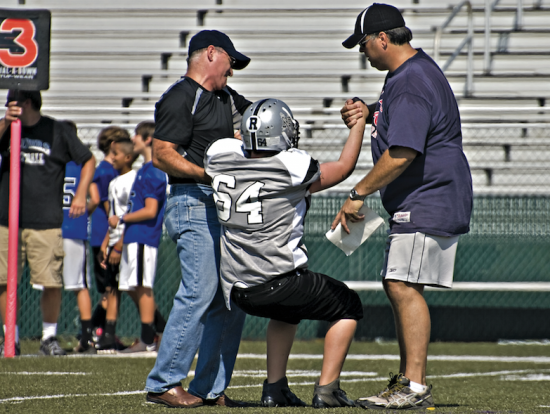The importance of athletic trainers
Athletic trainers are health-care personnel who are specifically trained to help diagnose, treat and prevent sports injuries in various settings. Their involvement in school sports and the care of athletes is evidence based to improve outcomes in general. They are trained to provide care while adhering to a code of ethics, which makes for excellent holistic care.
The presence of on-site health care is bound to become more important in coming years as student participation in sports continues to increase and school sports continue to become more popular. The conditions present in athletes have become increasingly more complex and are beginning to be understood as having long-term implications if not recognized and treated early; these include concussions, for instance.
With a return-to-play protocol that requires daily follow-up until an athlete is able to compete, having an athletic trainer available at a school not only lessens cost but also ensures that the return-to-play protocol is followed correctly by just one person — not various health-care providers who may see the student-athlete in clinic one day and then delegating him or her to a colleague on another day. With the intricacies of return-to-play after a concussion, consistency is a key factor in identifying the residual symptoms of a concussion versus the chronic conditions affecting an athlete that confound the concussion symptomatology.
With the intricacies of return-to-play after a concussion, consistency is a key factor in identifying the residual symptoms of a concussion versus the chronic conditions affecting an athlete that confound the concussion symptomatology.
The graded physical activity protocol that return-to-play requires is also best observed by one individual, and the athletic trainer is perfectly suited and trained for this. Athletic trainers spend a great deal of time with student-athletes both offseason and during the season. As such, they get to know the athletes’ usual abilities and personalities.
Any subtle changes that are hidden from a regular clinician’s eyes will stand out quite easily to a seasoned athletic trainer. An athletic trainer can identify when a student-athlete is not acting like him or herself. A parent can, too, but athletic trainers can characterize a patient’s “usual self” in an athletic environment to a level that most parents cannot.
Health and safety in student sports have been shown to benefit from the presence of athletic trainers in schools, yet only about 40 percent of high schools in the United States have athletic trainers. In professional and collegiate sports, having an athletic trainer is almost the standard. Given the clear benefits, it is somewhat strange that this is not so in high school sports.
Lack of funding is the typical reason schools do not have athletic trainers. In the long run, reduced injury rates, liability and medical expenses do pay for the cost of athletic trainers, though. For example, re-injury rates in high schools with athletic trainers have been shown in studies to be just 3 percent, while at high schools without athletic trainers they go up to about 60 percent.
An athletic trainer’s ability to respond to student-athlete issues in an expeditious manner may help translate to decreased costs for schools and for parents, not to mention the positive implications for the safety of the student-athletes. Cost savings arise from the avoidance of unnecessary physician visits and trips to the emergency room, which is simply because an athletic trainer is present to assess injuries on site.
The entire student body may benefit from having an athletic trainer in a school, as often, they may be better trained to address medical emergencies than other healthcare personnel or even school nurses. The media is replete with stories of athletes whose lives were literally saved because an athletic trainer witnessed a catastrophic event and was able to administer life-saving measures prior to the arrival of other healthcare providers.
Among the most worrisome injuries that frequently occur in sports are concussions. In high school sports, the presence of an athletic trainer makes it more likely that a concussion will be recognized quickly and intervention started early. This is important because the underdeveloped brain is at a greater risk of developing long-lasting complications stemming from a concussion. Young athletes take longer to recover from brain injuries compared to older athletes.
Often, safety measures are implemented after a near-fatal or fatal incident in sports. The presence of an athletic trainer in a school may, at least in the case of concussions, help make such incidents less likely to occur in the first place.
On and off the field, athletic trainers can give peace of mind to school staff, students and parents. Athletic trainers are prepared to educate student-athletes about exercise regimens, nutrition and healthy lifestyles. They are able to provide healthcare services during athletic events and on school grounds.
Every year an average of 12 football players die due to heat-related causes, brain injuries and heart conditions. Athletic operations that are run by certified athletic trainers are able to identify at-risk athletes earlier than schools with no athletic trainers. Heat-related deaths may be prevented by not allowing events to take place when the environmental heat index becomes unsafe, and athletic trainers are trained to monitor this. Furthermore, on the sidelines, athletic trainers and their team of students constantly stress proper hydration.
 On hot summer days, athletic trainers monitor the heat index and have the authority to cancel practice if conditions are too dangerous. Athletic trainers also ensure that athletes are properly hydrated, which prevents heat-related deaths.
On hot summer days, athletic trainers monitor the heat index and have the authority to cancel practice if conditions are too dangerous. Athletic trainers also ensure that athletes are properly hydrated, which prevents heat-related deaths.
The proper management of concussions and return-to-play from concussions may be better implemented with the help of athletic trainers. They have the ability to save athletes by relying on their training with automated external defibrillators, and they are often well trained to use them in a school setting.
Parents, coaches, athletic directors and school nurses often learn to work well with athletic trainers, and team physicians often find them indispensable allies in the care of student-athletes. Athletic trainers are able to implement a school’s athletic healthcare system under the guidance of the team physician. As mentioned, they often serve as first-line responders to injuries. Emergency action plans are often implemented by athletic trainers.
Along the way to recovery, athletic trainers provide important feedback that guides return-to-play decisions made by the sports medicine team. Programs to help condition athletes and prevent injuries can be created and implemented with the help of athletic trainers. The conditions for competition can be made ideal with feedback from athletic trainers.
Never forget athletic trainers can be key to making sure that athletes are prepared for competition and practice. They form a relationship with athletes in schools that often cannot be replicated by the student-athletes’ physicians or school nurses; this is because athletic trainers are present not only during the times when student-athletes are ill or injured but even when they are playing well after illness and injury. As such, they share in the gains from proper medical care and have an almost instantaneous incentive to get the student-athletes under their ward up and going.
The educational competencies and clinical proficiencies that athletic trainers have to pass prepare them for the unique role of being the only comprehensive school-based sports medicine healthcare personnel. Student-athletes benefit from this kind of training, which is based on clinical experience founded upon evidence-based classroom didactics.
The National Athletic Trainers’ Association ensures this level of competence through a certification system. Seventy percent of athletic trainers have a master’s degree or higher, and at minimum all of them have a bachelor’s degree. To clarify, personal trainers are different from athletic trainers, as the former focus mostly on conditioning and fitness. The education and certification requirements for the two disciplines are also quite different.
References
- Getz B. “The Importance of Certified Athletic Trainers in Athletic Programs.” Available at: http://www.hughston.com/hha/a.atc.htm. Accessed on 26 February 2015.
- National Athletic Trainers’ Association. “Athletic Trainers Fill a Necessary Niche in Secondary Schools.” Available at: http://www.nata.org/NR031209. Accessed on 24 February 2015.
- Saum K. “What’s a Life Worth to You? The Absolute Importance of Athletic Trainers in High School Sports.” Available at: http://theknockoutproject.org/wp/?p=338. Accessed on 25 February 2015.



